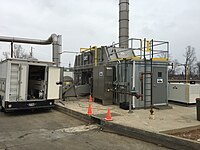
Photo from wikipedia
Abstract Materials composed of metals and plastic composites joined through adhesive bonding are being increasingly used. However, debonding of such materials may occur during manufacture or use. Non-destructive testing of… Click to show full abstract
Abstract Materials composed of metals and plastic composites joined through adhesive bonding are being increasingly used. However, debonding of such materials may occur during manufacture or use. Non-destructive testing of adhesive bonding structures is required to evaluate their debonding. Herein, electromagnetic pulse-induced acoustic testing (EPAT) was used to detect debonding at the adhesive joint in plastic composite/metal specimens. EPAT uses a pulsed excitation current to generate guided waves in a specimen to detect debonding without contact, which makes it suitable for testing from the plastic composite side. Simulations were performed to analyze acrylic/aluminum (Al) and carbon fiber-reinforced plastic (CFRP)/Al specimens. The results showed that the Lorentz force in the z direction was the dominant mechanism in the generation of guided waves, and mainly the A0-mode Lamb wave was excited. The simulation and experimental results revealed that for specimens where the mechanical parameters of the plastic composite layer differed greatly from those of the metal, such as the acrylic/Al specimen, debonding could only be detected directly above debonding. Therefore, it is necessary to evaluate the debonding position by scanning the receiver sensor. Conversely, for specimens with reasonably similar mechanical parameters of the plastic composite and metal layers, like the CFRP/Al specimen, the debonding position could be evaluated by scanning the receiver sensor or excitation coil.
Journal Title: Composites Science and Technology
Year Published: 2021
Link to full text (if available)
Share on Social Media: Sign Up to like & get
recommendations!